
Knowing how to handle no shows is incredibly important, given that sales reps spend on average 20% of their time researching leads and preparing for calls.
Getting ghosted with no shows can take a massive chunk out of productivity and revenue.
One study even estimates that every time a lead no shows, a rep loses 5% of their income for that week.
And let’s not forget about the toll it can take on morale. It’s brutal!
Here’s how to handle no shows effectively and keep your no show rate low.
How to Handle No Shows By Making Scheduling a Breeze
MarketingProfs did a study to see what the most common reasons for no shows are.
According to their findings, the number one reason hands down is that leads simply end up being too busy.
“56% of prospects missed their sales appointment because they were ‘overwhelmed by internal events,” says MarketingProfs.
And that’s understandable.
Most people have hectic schedules, and even with the best of intentions, they can get caught up in other things, which ultimately leads to them bailing.
If, however, you allow them to set a meeting time that works around their schedule, while making it dead simple to do so, you can slash through the problem and keep no shows in check.
As the old saying goes, an ounce of prevention is worth a pound of cure.
So, allowing leads to choose a meeting time that perfectly matches their schedule should be huge when figuring out how to handle no shows.
How to Handle No Shows By Following the 2 Week Rule
Keep meeting requests within a 14-day timeframe.
The more time that passes between when a lead schedules an appointment and the time in which it actually takes place, the greater the chances of them no showing becomes.
After all, they’re more likely to forget about it or simply blow it off.
I like what Steli Efti of Close.com has to say about it.
“Sure, your prospects are probably willing to schedule something for next month when their calendar is clear. But in the next 30 days, that calendar is going to fill up. And the more time passes between your initial meeting, the less important you’ll be.”
That’s why I recommend setting up your scheduling options so that leads have to choose a time within the next two weeks.
I find to be a good sweet spot because it gives leads adequate wiggle room to choose a convenient time but is soon enough that they’re unlikely to forget about it.
How to Handle No Shows By Using Shorter Calendar Slots
Another factor that contributes to no shows is the length of a meeting.
Research has found that leads are more likely to show up to shorter meetings, which require a smaller time expenditure than they are to longer ones that take more time out of their day.
More specifically, “you’re 12% more likely to get a prospect to show up to your first meeting if you send a 30-minute calendar slot rather than a 60-minute one.”
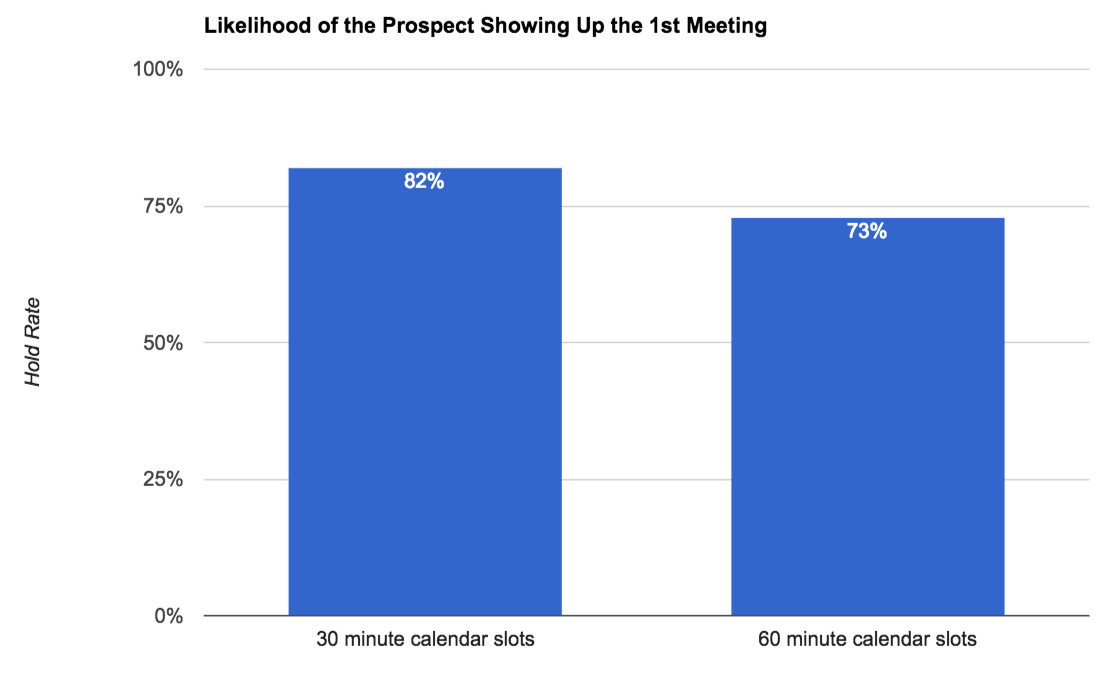
And if it’s less than that — say only 15 or 20 minutes — then I could only imagine that your no show rate would drop even further.
This isn’t to say that a meeting should be cut short where reps rush through and fail to cover critical points.
But they should definitely be cognizant of how long their meetings take and trim off any extraneous parts that will eat up time.
Also, be sure to let leads know how long they can expect the meeting to take, ideally letting them know the meeting time the moment they’re scheduling it.
Follow the formula of keeping it at 30 minutes max, and you can expect to see a noticeably lower no show rate.
How to Handle No Shows By Using Automated Reminders
Another great way to keep no shows at bay is to remind a lead of an upcoming meeting at key intervals.
Here’s how it works.
First, you set up a sequence of reminders to keep the meeting fresh on their mind.
For example, you could set up a reminder to be sent out one hour before giving a demo.
Then, you create a customized message like this.
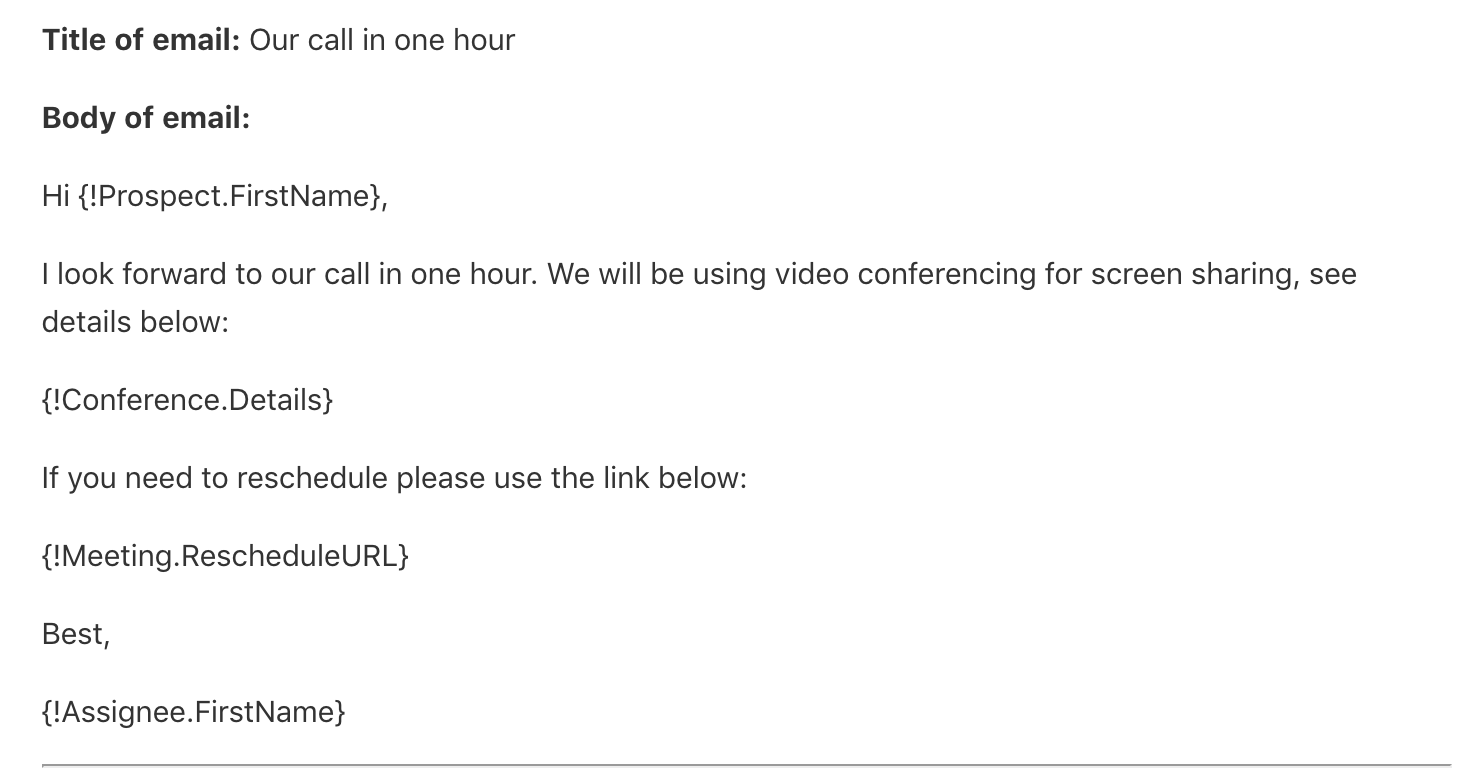
The lead will automatically receive it an hour before the call, giving them time to prepare.
And to reduce the odds of them no showing even more, you could set up another automated message that’s sent one minute before the demo.
Then, one minute before the meeting, the lead will receive another personalized message that looks like this.
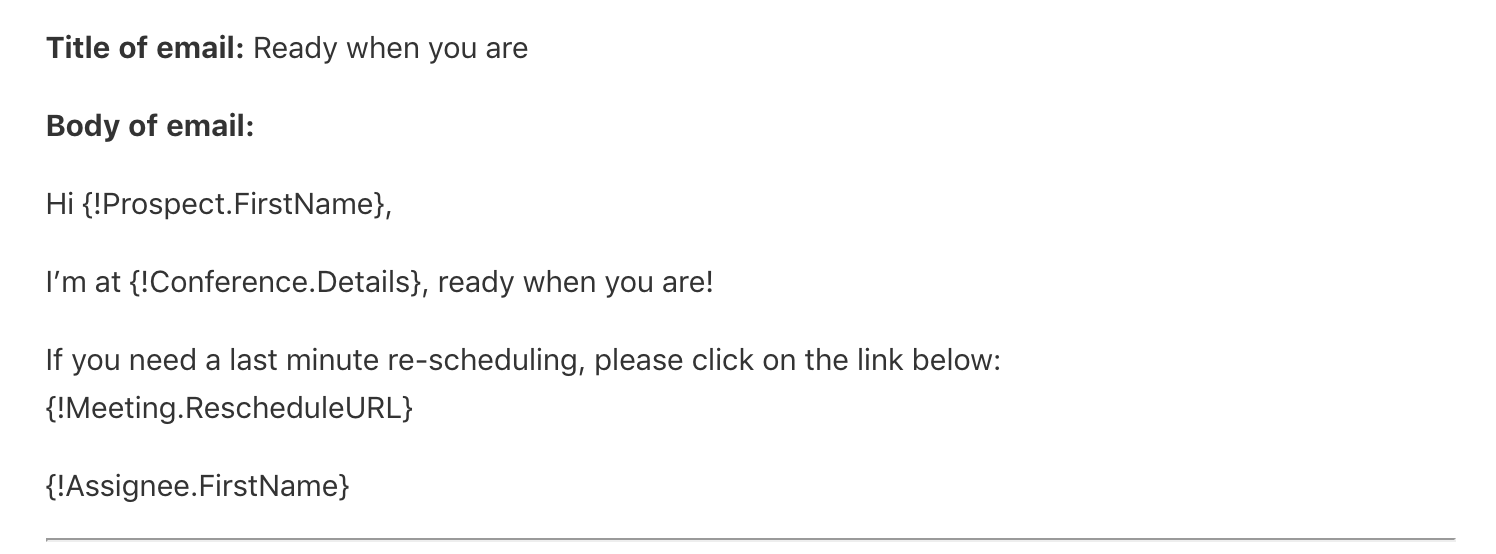
So in a very polite, subtle way, you’re able to elbow nudge a lead and let them know it’s time for a meeting.
That right there is usually enough to get the vast majority of leads to show up on time without any drama.
How to Handle No Shows By Sending Different Types of Reminders
Email is usually the most common method of sending reminders.
But it’s not the only option.
Consider sending SMS texts as well. Just follow the same process that you did with email reminders where you select the times in which you want to send texts and create a personalized message.
And you can take it one step further by making reminder phone calls, and if possible, in-person reminders by dropping off letters.
You don’t want to be a pest about it, but casting a wider net like this should help the meeting stay on the lead’s radar and lower the chances of a no show even more.
Share Valuable Content Between the Time a Meeting is Booked and When it Takes Place
Let’s say that a lead has booked a meeting with one of your reps, and it’s set to take place 10 days after the day it’s booked.
Your rep has two choices during this period.
They could A) bide their time and have no additional contact after they’ve confirmed the meeting.
Or, they could B) keep the communication flowing by letting the lead know they’re available to answer any questions or concerns they have and share valuable content so the lead goes to the meeting with more knowledge on how your product works and how it can help their business.
Which is the better option?
B, of course!
Scheduling meetings and closing deals is all about capitalizing on momentum.
Whenever a lead decides to officially book a meeting, they’re showing a high level of interest.
But as time goes on and communication goes static, that interest level often wanes.
Your salespeople can ride the wave of momentum by sharing valuable content like videos, eBooks, case studies, webinars, and so on.
Studies have found this to be an excellent way to avoid lulls in the conversation and keep your brand fresh in the mind of leads while reps are waiting to hold a meeting, with these types of content working the best.
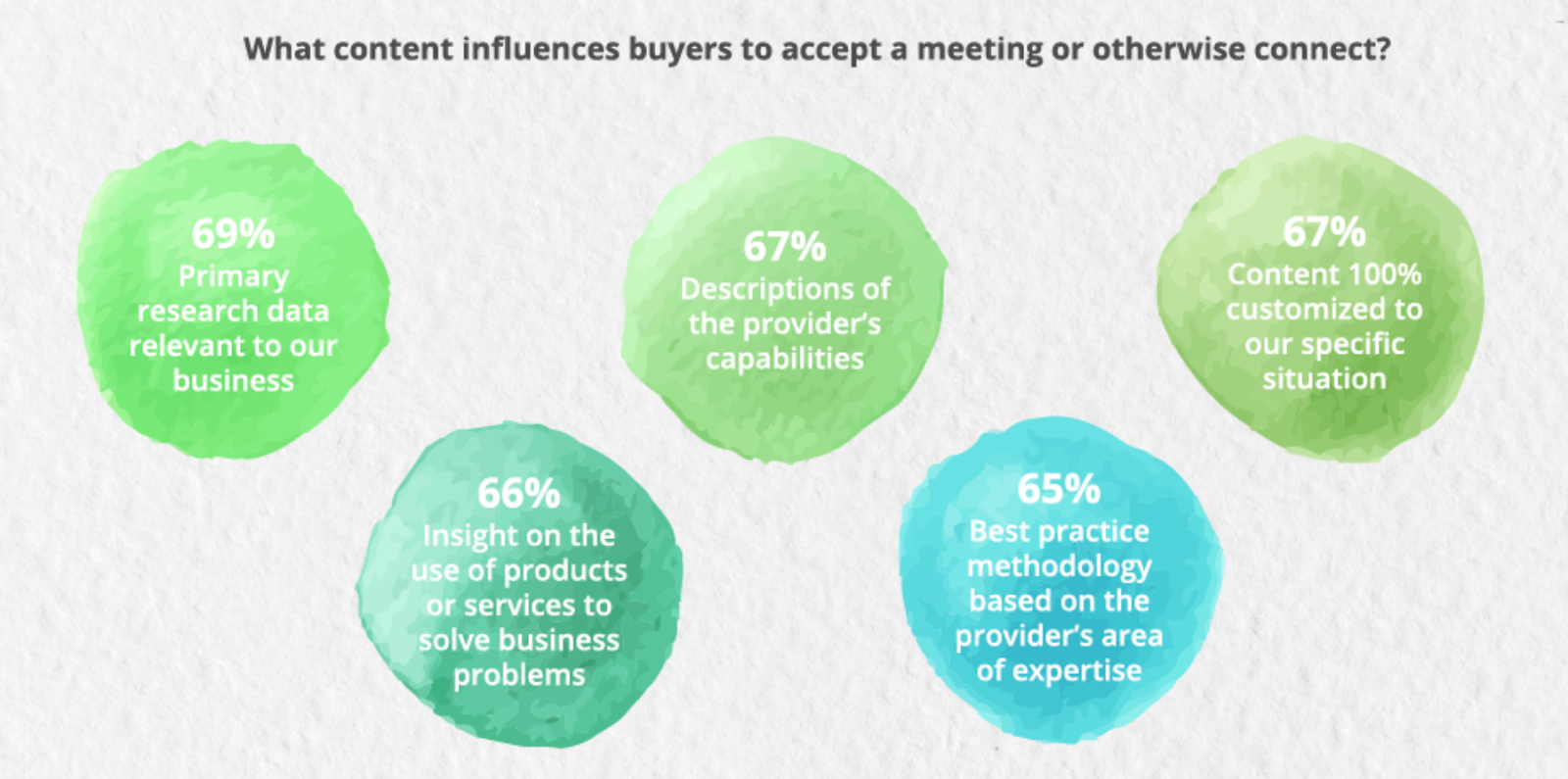
Make it Painless to Reschedule
Up until this point, I’ve gone over ways on how you can use preventative measures to lower the chances of no shows occurring.
And I can say from experience that they can take a massive chunk out of no shows and get your rate way below the average of 20 – 35% that many of today’s companies experience.
But what about the leads that have officially flaked out?
You want to make it as painless as possible for them to reschedule, because after all, it’s better to have a meeting late than never at all.
Here’s how to handle no shows that have already missed their scheduled meeting.
First, consider creating an automated sequence for no shows.
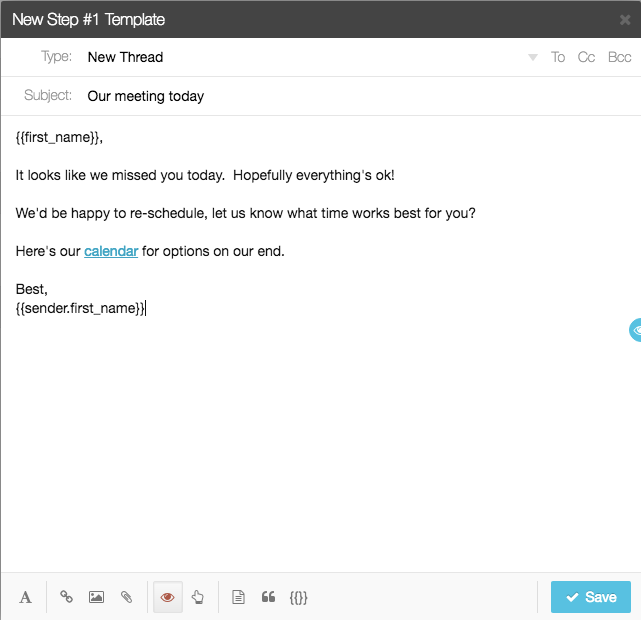
Just like with the initial scheduling, this lets a lead choose a time that’s convenient for them.
With any luck, they’ll go ahead and reschedule, and you can pick up where you left off.
If the new time they select meshes with the rep’s schedule, they can simply go through with the meeting no problem.
Otherwise, if the original rep isn’t available at the new time, they can have another rep take it instead.
Also, be sure to have reps respond with an even tone because it’s easy for a negative tone to creep in after feeling slighted like this, says Claire Murdough of HubSpot.
By making it no hassle to reschedule and not being moody about it, you should be able to still have meetings with leads that would have otherwise slipped through your fingers.
It’s just a matter of knowing how to handle no shows effectively without souring any relationships.
FAQs on How to Handle No Shows
What’s the average no show rate for sales meetings?
20 – 35%
How low can you realistically get your no show rate down to?
At Chili Piper, we’ve been able to get our no show rate down to just 2% — a number that’s realistic as long as you follow the right techniques for how to handle no shows.
What are some specific techniques for how to handle no shows?
- Make it simple and convenient for leads to schedule meetings when it’s best for them
- Follow the 2 week rule where meetings must be scheduled within 14 days after booking
- Keep meetings at 30 minutes max
- Send automated reminders through different mediums such as email, text, phone, or in-person letters
- Share relevant, valuable content with leads during the period when reps are waiting to have their meeting
- Make rescheduling simple and seamless
How to Handle No Shows Like a Champ
No matter how professional your sales team is and how well they do their jobs, reps are bound to get ghosted from time to time.
It’s inevitable.
That’s why it’s important to know how to handle no shows — something that requires preventative measures and a smooth response for whenever a lead bails.
Following the strategies I’ve outlined here should help you do both, allowing you to lower your no shows dramatically and reschedule with the ones that don’t show up initially.